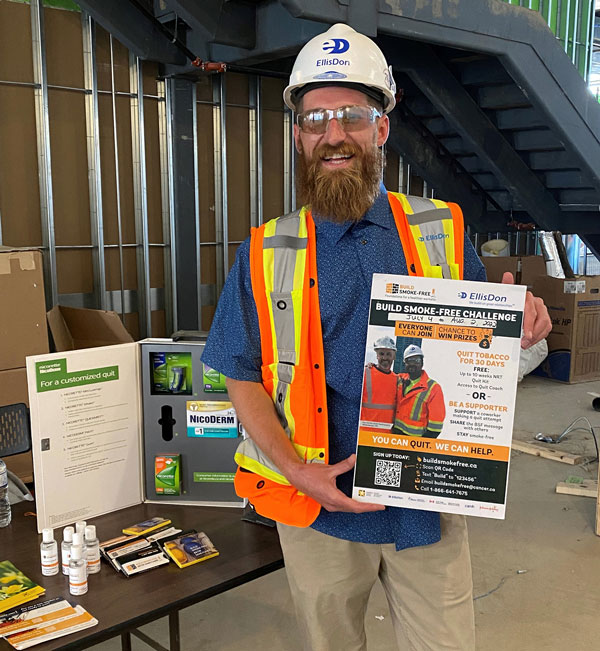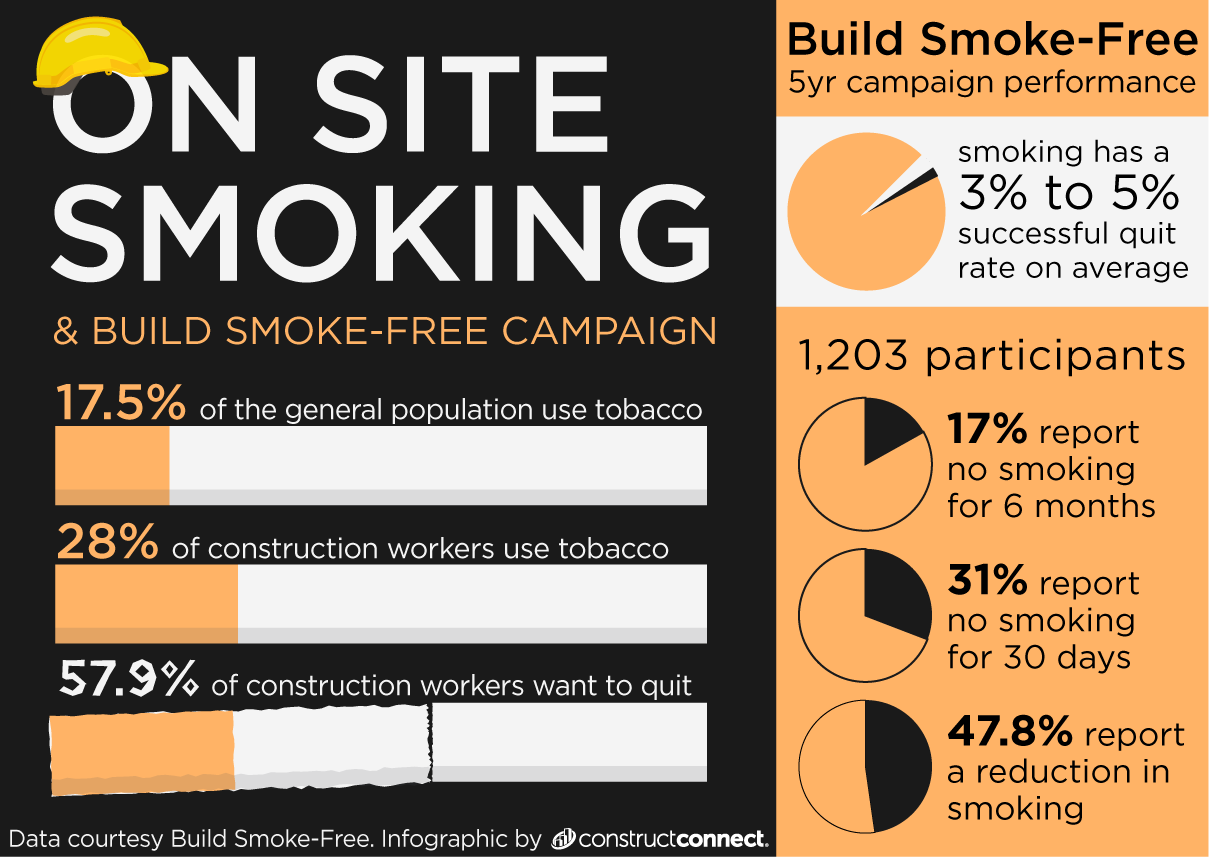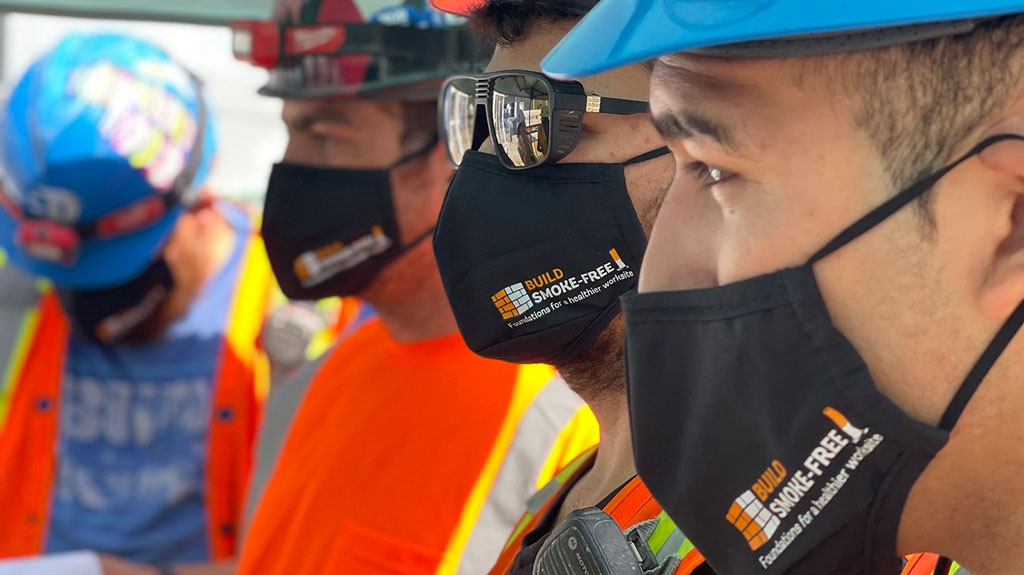Five years in, the Build Smoke-Free campaign to convince tobacco smokers on construction sites to break their addiction has produced remarkable results but the program itself is at a crossroads.
Ottawa Public Health nurse Heidi McKean has been spearheading tobacco control programs for 15 years and in the past decade has focused on construction.
Five years ago EllisDon signed on as a major national supporter and participant, working with such partners as the Canadian Cancer Society, CAMH, the Ontario Tobacco Research Unit and the Public Health Agency of Canada to develop the Build Smoke-Free project.
All agreed tobacco usage numbers are concerning. It has been determined that 28 per cent of construction workers use tobacco, compared with 17.5 per cent of the general population.
“Smoking on construction sites seemed to be a normalized culture,” said McKean. “There are strong role models onsite, the journeymen are the role models for the apprentices coming on. We are hearing some construction workers say, ‘I never smoked until I got onto the site.’”
McKean noted construction work remains a predominantly male culture, and many men do not readily seek out health care. Optically, new workers see smokers congregating at the front of a site, creating a sense of normalcy.
“So that combination, that’s where tobacco use has stayed high.”

The program, developed by the various public health agencies and honed by EllisDon, is comprehensive and ambitious, noted Doug Van Moorsel, Toronto area director of health, safety and environment for EllisDon.
The construction sector has a strong safety culture to begin with, he said, and working with the multiple tiers of public health agencies paid dividends.
“I couldn’t think of better people to work with,” said Van Moorsel. “They are so like-minded with EllisDon and what we do and what we’re about. They just work relentlessly to make this program work.”
The administrators found that 57.9 per cent of smokers in the sector want to quit but there are a lot of relapses. It was stressed that each quit attempt builds skills, and even just cutting back was a pathway to future success.
The quit results were impressive, McKean said. A total of 1,203 workers across Canada have quit smoking, with 31 per cent reporting 30 days of no smoking after six months and 17 per cent reporting six months of smoking abstinence.
The quit rate with the program is far above the three- to five per cent average success rate of unaided quit attempts.
Additionally, 47.8 per cent of current smokers reduced the number of cigarettes smoked daily, and 65.9 per cent of participants agreed that the program created a work environment that helped them quit or cut back on smoking.

“It was continual growth,” said Van Moorsel. “I think the value of this program made itself evident really quickly. Then when you see that value, people are willing to put in the effort.
“All those people that quit smoking long-term, it’s a massive benefit.”
As an added incentive, workers were told quitting saves between $3,500 and $6,000 per year.
Even abstaining for eight hours returns blood oxygen levels to normal, while carbon monoxide and nicotine levels fall by half. In one year, the risk of heart disease is cut in half.
Employers, meanwhile, benefit from more focused workers, increased productivity, decreased sick time and less time spent on breaks.
“The cost savings was one of our pitches and that’s what resonates with the construction industry because time is money,” said McKean.
She points to one testimonial she has heard, from a former smoker named Adam.
“He says, ‘It changed my life.’ How many times have I heard that? That’s what keeps us going — how could it not?”
If there is one cloud over the program it’s that Build Smoke-Free’s current five-year program comes to an end this March. McKean said the final phase was intended to explore program sustainability, with the Canadian Cancer Society and the other team members looking for new funding partners as part of a transformed Build Smoke-Free 2.0.
So the drive is on to find a new group of interested parties who will be part of the next iteration.
EllisDon will remain a strong and involved supporter and will continue to spread the word to other companies and unions. But Van Moorsel said the firm will have a new focus as well, launching a legacy committee that will take the lessons learned and implement them internally.
“It’s a matter of taking that momentum, all those learnings and trying to apply them across as broad a scope as we possibly can,” he said.
Follow the author on Twitter @DonWall_DCN.











Thank you for Don Wall for your positive and informative views into the efforts of the many committed individuals working to support and improve the lives of construction workers across Canada. I always look forward to your articles which are often a highlight of my day.